105
Elasticity
5

106
Learning Objectives
5.1 Understand the concept of elasticity and why percentages are used to measure it.
5.2 Describe the difference between elastic and inelastic demand.
5.3 Describe the determinants of price elasticity of demand.
5.4 Compute the price elasticity of demand using the base and midpoint methods.
5.5 Describe the relationship between total revenue and price elasticity of demand.
5.6 Describe cross elasticity of demand and use this concept to define substitutes and complements.
5.7 Use income elasticity of demand to define normal, inferior, and luxury goods.
5.8 Use the concept of price elasticity of supply to measure the relationship between changes in product price and quantity supplied.
5.9 Describe the time periods economists use to study elasticity, and the variables that can be changed in each period.
5.10 Describe the relationship between elasticity and the burden and incidence of taxes.
At the start of the new millennium, the price of gasoline hovered around $1.50 per gallon. Encouraged by low gas prices, consumer appetites for large vehicles rose, leading to an increase in sales in sport utility vehicles (SUVs) and trucks. Over the next ten years, however, increased tensions in the Middle East and a large spike in oil demand from emerging markets such as China and India pushed the price of a gallon of gas to over double what it was in 2000. How did consumers respond to the 100% increase in the average price of gasoline? They reduced consumption by driving less, buying more fuel-
When global oil prices rose significantly, not only did consumers respond by reducing the amount of gasoline demanded but producers also reacted by increasing oil drilling in previously untapped oil fields. As a result, the United States and countries in Africa and Northern Europe became major oil producers, adding to the supply of gasoline on the market. But by how much did the quantity of gasoline supplied increase?
Not only did higher prices change the quantity demanded and supplied for gasoline. It also affected the demand and supply for related goods. For example, rising gasoline prices led to an increase in demand for fuel-
We learned in a previous chapter that consumers respond to higher prices by buying less, while producers respond to higher prices by producing more. We also know that as prices rise, demand for complements falls while demand for substitutes rises. However, we have not yet measured the extent of such responses. In other words, how responsive are consumers and producers to changes in prices in terms of what and how much are purchased and produced?
We answer the important “how responsive” question in this chapter by studying how consumers and producers respond to changes in the price of goods and services.
“Elasticity”—the responsiveness of one variable to changes in another—
Yet, as our example shows, elasticity can be measured for many other related goods that are affected by the change in price. If the price of gasoline changes, how will this affect sales of SUVs? Plug-
Elasticity is a simple economic concept that nonetheless contains a tremendous amount of information about demand for specific products. If a restaurant raises its menu prices by 10%, will it end up with more revenue, or will the increase in price lead to a drop in quantity demanded that more than offsets the price increase? Knowing a product’s price elasticity allows economists to predict the amount by which quantity demanded will drop in response to a price increase, or grow in response to a price decrease. The concept of elasticity helps you to put supply and demand concepts to work.